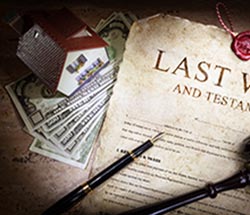Addendum to a Will - How to Make A Codicil
An addendum to a Will requires a document referred to as a Codicil to Will. When you make a Codicil to Will you need to follow the legal requirements and give clear instructions as to the interpretation of amendments that you want to make to your last Will.
The Codicil will then form part of your last Will and both documents are read as one during probate.
It must be captured in a physical form e.g. typed on a computer and printed out. Therefore an oral rendition does not qualify - you cannot simply say to someone that you are adding or deleting a beneficiary in your Will.
It then needs the second part:

Execution - It must comply with the formal requirements that stipulate, for example, how many witnesses are required and whether it needs to be notarized, and so accordingly signed i.e. duly executed.
That is how to add an addendum to a Will and make a Codicil to Will legally valid.
Writing a Codicil - Firstly Review Your Last Will
Before you get started with drafting your Codicil, refer to your Will and make notes of the clauses and their numbers and the changes or updates that you want to make to these clauses. Do not make any scribblings on the Will itself.We have a free Codicil to Will form implementing the below simple steps that you can use as a template. We also illustrate how to cross reference to the clauses in a Will.
How to Make a Codicil - Follow these 7 Steps- Identify your document - clearly state that it is a Codicil to your Will.
- Identify yourself and specify your address.
- Add the date of your Will to make it clear to a court which last Will this Codicil refers to. If at a future date you execute a new Will, you will be revoking all previous Wills AND Codicils and this Codicil will become redundant.
- Add a declaration that you are of legal age, of sound mind and not under undue duress or influence.
- Cross reference the relevant provision/clauses (if applicable and if you can) in your Will that you wish to change, for example:
- You want to appoint a different executor;
- You want to make an additional bequest;
- You want to make a change of property, etc. - State that the provisions in this, your (first), Codicil replace those in your Last Will and Testament of a certain date but that any provisions not so altered must remain valid.
- Sign and have it witnessed as per the legal requirements of a last Will in your jurisdiction.
You now have a Codicil (as an addendum to a Will) which must be kept together (not stapled) with your Will.
A couple of important notes to the above steps in making a Codicil:
- Be specific by using full legal names of persons, giving a proper description of property or specific value amounts.
- It will also be helpful (not a legal requirement) to specify the context within your Will where additional clauses should be read, for example: I am adding the following after clause 2.
This is because your Will and Codicil(s) will be read and interpreted as if they are one document.
You can cite sections, paragraph numbers (or even a page number if need be) to identify the portion(s) of the Will that you are amending. - Take care not to add a clause cancelling or revoking previous Wills, lest it cancel the Will that you meant to update only.
- Because there are no limits in law as to the number of Codicils you may have, you should clarify whether this is your first / second / third etc. Codicil.
- Incidentally, you can also use a Codicil to reaffirm the provisions in a Will if you are concerned that it may be contested by beneficiaries or people not named in your Will. For example, your will may be decades old and you want to affirm your wish to be cremated or affirm a gift to a charity.
Who Can Witness a Codicil / Addendum to a Will?
Let's follow the rule of thumb here (although some states may be relaxing the requirements for a Codicil) and accept that the same rules for executing a Will, also apply to a Codicil.

The requirements for witnesses to a Codicil are simply:
- Witnesses may not be beneficiaries in the original Will or subsequent Codicil to Will if the changes made will benefit them. In some jurisdictions they may also not be an appointed executor or guardian. It is safest to choose witnesses that have no interest in your Will or your Codicil;
- They need to be mentally competent i.e. able to give evidence in court should they be called upon to do so;
- They must be of the required age (which is not necessarily the same as legal age) to witness a Will.
If the Codicil is executed at a later time than the original Will, then it need not have the same persons as witnesses again.
Self-Proving Affidavit
Although it may not be a requirement in your jurisdiction, a Self-Proving Affidavit acts as an extra layer of proof as to the validity of your document. You and the witnesses will attest under oath in the presence of a Notary Public or Commissioner of Oaths as to the nature of the document and that the signature of the testator was duly witnessed.
If a self-proving affidavit is accepted (not all states do) then the probate process can be faster because witnesses will not need to testify in court to having witnessed the testator’s signature.
If you need to draft a new Will, then you can follow the easy steps that we describe in this article: How to Write a Will.Addendum to a Will - Asset List or Personal Property Memorandum
You may want to have an asset list or personal property memorandum which details the tangible pieces of property that you wish to bequeath. You need to make reference to this in your Will (in the section dealing with beneficiaries or specific bequests) so your personal representative, commonly referred to as your executor, knows of its existence and the instructions therein. For example:
"I leave my personal property as per the Memorandum that is attached to my Will"
If you have tangible assets such as a jewellery collection or notable pieces of furniture, silverware etc., and you wish to leave specific gifts to beneficiaries, you can do so in this Memorandum.
Real estate, and intangible assets such as stocks / bonds / bank accounts must be noted in the Will itself and not in your Memorandum.
Changing an Addendum to a Will
It is natural for this list to need amendment from time to time as you dispose of some property and acquire others.
You could simply write "Revoked" across each page, add the date and your signature and draft a new list to accompany your Will. In many jurisdictions the courts will accept this without it being witnessed. However, in another jurisdiction if you want to incorporate any other documents into your Will you may need to comply with the formalities of a Will and have it duly signed and witnessed.
Addendum to a Will - Letter of Wishes
Unlike a Will, a letter of wishes is not a legally binding document and it does not become a public document (as with a Will upon grant of probate), but remains confidential.
Note: Instead of an asset list (as discussed earlier) you could list your personal property, such as your jewellery, in your letter of wishes and detail how you want to distribute them.
The aim is to guide people who need to make discretionary decisions after your death and here you can inform them in your own words what you wish them to do.

For example:
- You funeral wishes;
- Distribution of personal property;
- Your wish for the religious instruction of your children;
- Guidance to trustees on how you want a trust to be administered;
- Information to make the job of your executor easier - where to find documents;
- Explanation of a particular gift or why you have excluded someone from your Will;
- The existence of life insurance policies, bank accounts, company shares or investments.
Take care not to have anything that conflicts with your will because the intent of this letter is to be in support of the provisions in your Will i.e. to make it easier for your executor to administer your estate.
You can update your letter of wishes as often as you want. Add the date and sign it, but unlike a Codicil to Will, you do not need to have it witnessed.
Keep it with your Will and inform trustworthy people of its existence and where you've stored it.
How to Word a Codicil to Add Bequests
An instrument often used to effect this, rather than executing a new Will, is by means of a Codicil to Will.
But do consider the following for a minute:
The terms heir and legatee (receives a legacy) are often used interchangeably for beneficiaries.
Heirs and legatees can be a natural person, institution, club, society, legal entity etc. (Note that animals cannot inherit. Provision for a beloved pet can be made by establishing a trust or making financial provision and entrusting a person with the pet's care.)
Furthermore:
- A legatee inherits a specified amount of money or asset. And if that asset is no longer available because it was alienated or destroyed before the testator's death, then the legacy falls away.
- An heir typically inherits the remainder of the estate.
However! There is a distinction when it comes to devolving the estate i.e. when the time comes for the executor to distribute the assets.
And this is why a testator needs to be mindful of the possible outcome after his death. Take a look at the example below.
Heir vs Legatee

The testator bequeaths a specified amount as legacy to his club (or university or a charity etc.) and the family home and remainder of his estate to his daughter.
Upon his death, the executor of his estate must in the following order:
- 1. Settle the debts of the testator;
- 2. Pay to the legatee the specified amount; and
- 3. Hand over the family home to the daughter.
Unfortunately the testator incurred a huge amount of debt before his death and the executor has no choice but to sell the family home to firstly pay the debts and pay out the legacy. The daughter now cannot inherit the home as the testator intended.
So if you do not want to make a contribution during your lifetime, but do want to leave a legacy for example, to the trust fund of your alma mater upon your death, then consider the following wording:
"I bequeath five percent of the remainder of my estate, property and effects, after all debts have been settled, to my alma mater, the College of Agriculture of the following address as an unrestricted gift."
Or
"I give to the College of Agriculture of the following address the unrestricted gift of $ ______ provided that I have sufficient cash reserves to honour this gift after the settlement of any debts I may have."
Difference Between a Restricted and an Unrestricted Gift
With a restricted gift the testator will specify exactly when / where he wants the gift to be utilized (e.g. for research into the treatment of post-chemo neuropathy) whilst with an unrestricted gift the donor has not set any limitations on how the gift can be used.
Incidentally, a legatee cannot inherit if a person dies intestate, i.e. without a Will. A legatee has no rights under intestate succession. That being said, should a will become invalid or be revoked for any reason and the testator does not create a new will in its place, all clauses of the old Will shall become invalid and unenforceable. It follows then that if the (now invalid) Will included a bequest to a legatee, the legatee would have no valid claim in law.
Addendum to a Will to Allow for Substitution
Another instance where a testator may want to execute a simple Codicil to Will to add a beneficiary, is when life changes may make a bequest in a Will impractical, and the testator wants to make provision for such an eventuality.
For example:
“I bequeath my vintage car collection to my son but should he choose to remain overseas and, as such, incapable of maintaining the collection then I bequeath it to the local vintage car museum”.
A beneficiary (heir or legatee) can decline a bequest for any number of reasons. As seen with the above example, the testator can make provision for substitution so the asset does not revert to the estate to be distributed according to the provisions in the Will.
Failure of a Legacy
- The legatee dies before the legacy passes to him;
- The legatee repudiates i.e. rejects the benefit or refuses to inherit;
- The legatee is unfit to inherit (e.g. signed as witness to the Will or Codicil).
Where to Store Your Codicil to Will or Any Addendum to a Will
Your Codicil to Will is part and parcel of your Last Will and Testament and you need to keep the two documents together (as well as your second Codicil or third etc.). If the Codicil is lost or destroyed, any amendments that you made will not come into effect.
If you've filed your Will with your county for safekeeping, you should do the same with any Codicils.
Can You Have Duplicate Copies of a Codicil to Will?

You can make more than one signed copy of your original Last Will and your Codicils i.e. make multiple copies and then you and your witnesses sign them all.
Keep a copy for yourself and give other duly executed copies to trustworthy persons. Inform your family and heirs where they can find your documents after your death so they do not have difficulty obtaining them.
A copy of a signed Will or Codicil is not deemed valid.
When making an addendum to a will, it will be helpful for you to review the additional information on our Codicil to Will page where we cover:
- The legal requirements for a Codicil
- Making handwritten changes on a Last Will
- Why a Will is better than a Codicil
- If you can have a second / third Codicil
- Whether a Codicil can be contested
We also provide guidelines on how to revoke a Will and supply a free Revocation of a Will form.
Legally reviewed by: MD Sawyer (LLM) February 2022You are here:




